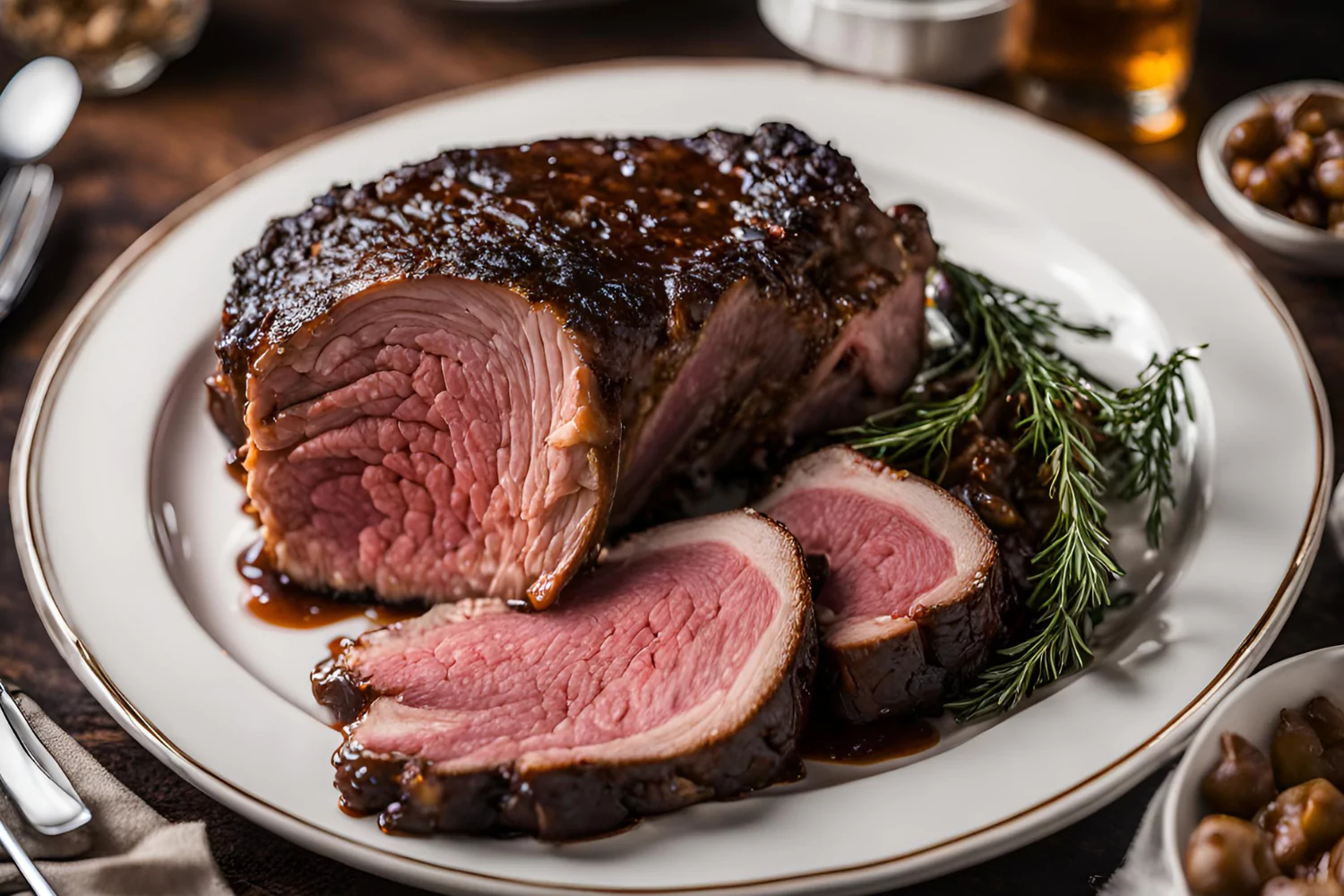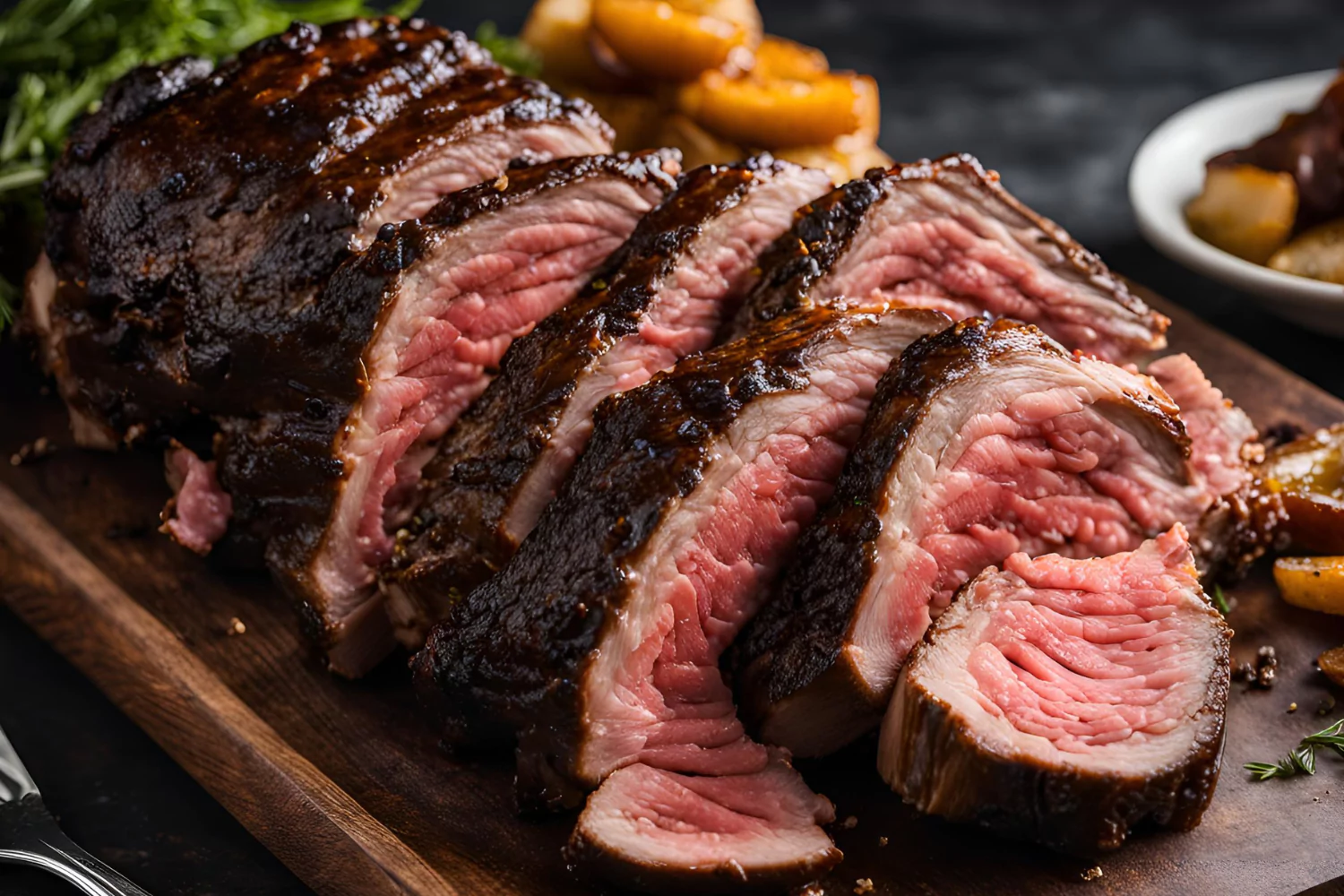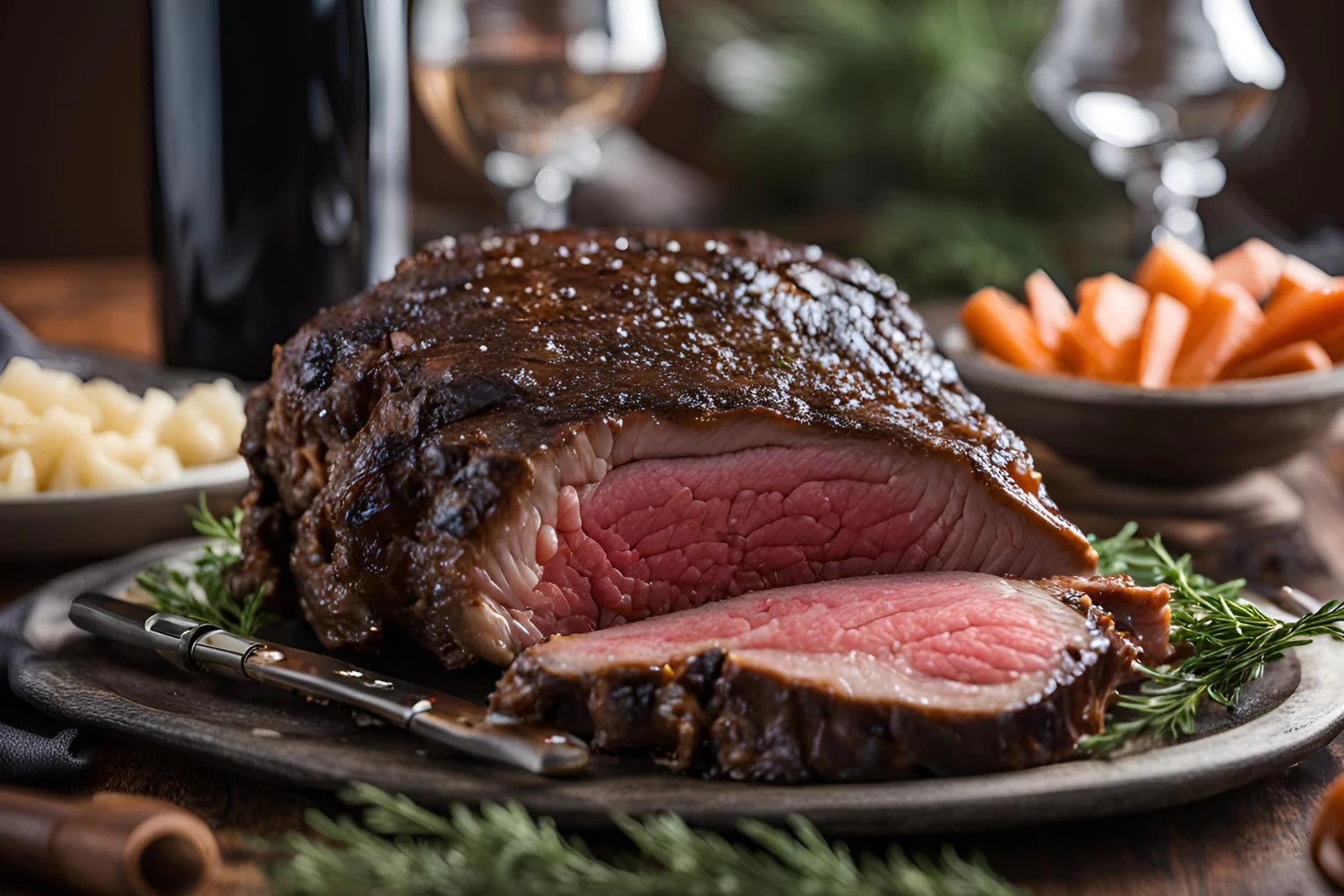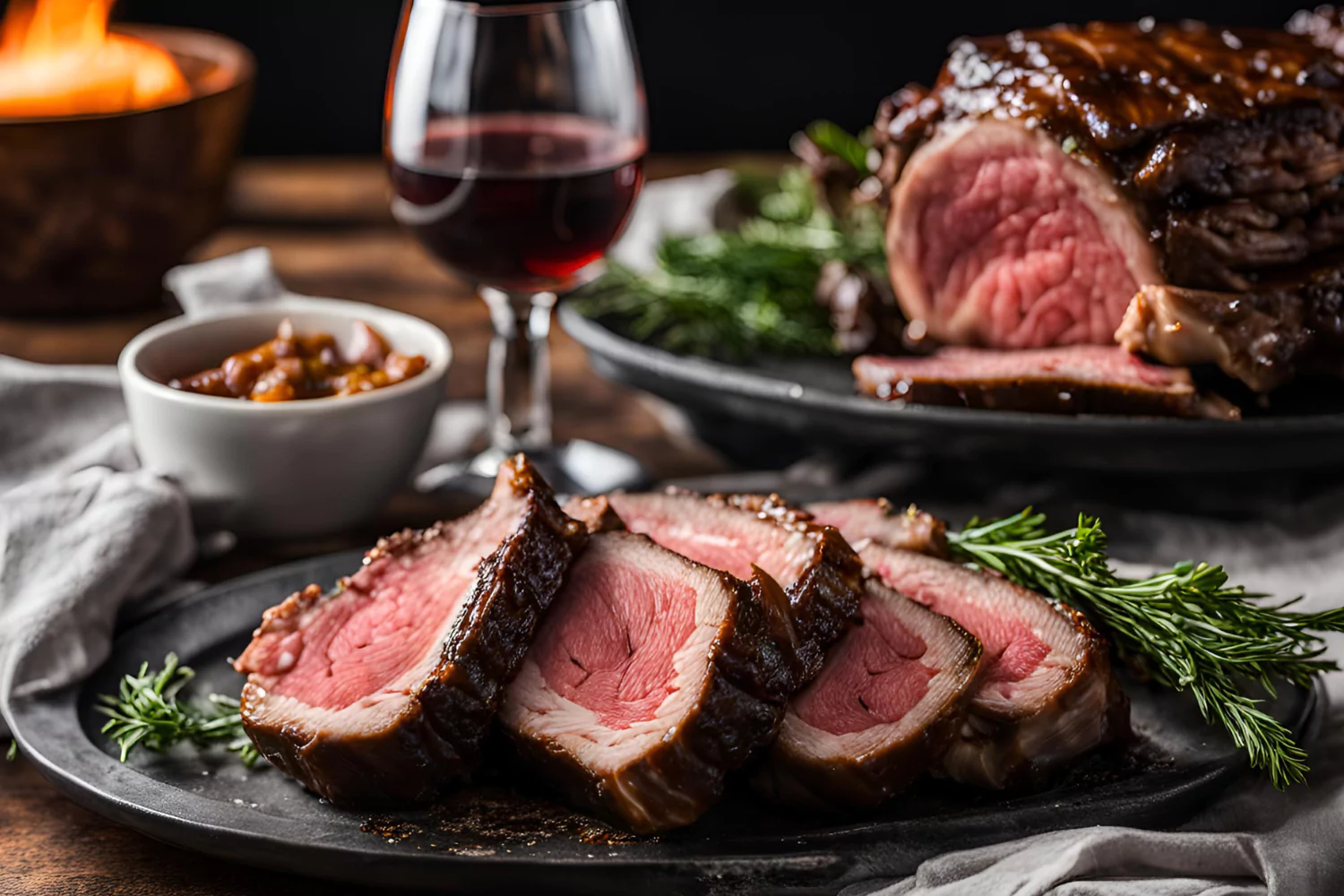Smoking prime rib to perfection requires a blend of time, temperature, and technique. This guide will walk you through the process from preparation to the final juicy slice, ensuring your prime rib is the star of any meal.
Introduction
Smoking prime rib offers a flavor that’s hard to beat. Whether you’re a seasoned pitmaster or a beginner, understanding the nuances of smoking this cut of meat can elevate your cooking game. Let’s dive into the essentials of how long to smoke prime rib and achieve mouth-watering results.
Choosing the Right Prime Rib
Selecting the best prime rib is the first step to a successful smoke. You can opt for bone-in or boneless, each with its unique benefits.
Bone-in vs. Boneless Prime Rib
- Bone-in prime rib cooks faster and stays moist.
- Boneless prime rib is easier to slice and serve.
When shopping, look for well-marbled meat. This ensures tenderness and flavor.
Essential Tools for Smoking Prime Rib
To smoke prime rib effectively, you’ll need specific tools. Here’s what you’ll need:
- Smoker: Consistent temperature control is key.
- Meat Thermometer: Ensures precise internal temperature.
- Cutting Board and Sharp Knife: For easy carving.
Having these tools ready makes the process smoother and more enjoyable.
Trimming and Seasoning the Prime Rib
Before you start smoking, prepare your prime rib by trimming and seasoning it.
Trimming Excess Fat
- Trim excess fat to about 1/4 inch thick.
- This helps the seasoning penetrate better.
Seasoning Techniques
- Dry Brining: Season with salt and let it rest overnight.
- Rub and Marinade: Use a mix of garlic, mustard, and herbs for a flavorful crust.
Seasoning is crucial for enhancing the meat’s natural flavors and ensuring a delicious crust.
Setting Up the Smoker
Proper smoker setup is vital for smoking prime rib.
Preheating the Smoker
- Preheat to 225°F.
- Use wood chips like hickory or apple for a rich, smoky flavor.
Consistency in temperature ensures even cooking and a perfect smoke ring.
Smoking the Prime Rib

Now, let’s get into the smoking process.
Smoking Times Based on Doneness
- Rare: Smoke until internal temperature reaches 120°F (30-35 minutes per pound).
- Medium Rare: 130°F (35-40 minutes per pound).
- Medium: 140°F (40-45 minutes per pound).
Using a meat thermometer, check the temperature regularly to avoid overcooking.
Resting the Prime Rib
Techniques of Resting
- Remove the prime rib from the smoker.
- Tent with foil and let it rest for 30 minutes.
Resting allows juices to be redistributed, making the meat tender and juicy.
Reverse Searing the Prime Rib
To finish, reverse sear the prime rib for a perfect crust.
Steps for Reverse Searing
- Preheat the oven to 500°F or your grill to high heat.
- Sear the prime rib for 10 minutes.
This step gives the prime rib a beautiful, caramelized exterior.
Serving Suggestions
Once your prime rib is perfectly smoked and seared, it’s time to serve.
Carving the Prime Rib
- Slice against the grain for maximum tenderness.
- Serve with sides like mashed potatoes or roasted vegetables.
Proper slicing ensures each bite is tender and flavorful.
Expert Tips
A few expert tips can make a big difference.
Avoiding Common Mistakes
- Don’t overcook: Use a thermometer to check the temperature.
- Maintain moisture: Keep the smoker closed as much as possible.
These tips help in achieving a perfect smoked prime rib every time.
Storing and Reheating Leftovers
Got leftovers? Here’s how to store and reheat them.
Storing Prime Rib
- Wrap tightly in plastic wrap.
- Store in an airtight container.
Reheating Tips
- Reheat in the oven at 300°F until it reaches 160°F.
- Avoid microwaving to prevent losing tenderness.
Proper storage and reheating keep your prime rib delicious even the next day.
Timing Adjustments Based on Prime Rib Size and Type
Understanding how long to smoke prime rib can vary significantly based on the size and type of your prime rib. Let’s break down the nuances to help you master the timing for your specific cut.
Adjusting Smoke Time for Different Weights
- Lighter Cuts (Under 10 lbs): These may require slightly less than the standard 30-45 minutes per pound, especially if aiming for rarer doneness.
- Heavier Cuts (Over 15 lbs): Expect to extend smoking times, potentially exceeding 45 minutes per pound, to ensure even cooking throughout.
Bone-In vs. Boneless Considerations
- Bone-In Cuts: These generally cook a bit faster due to the bone conducting heat internally, helping to cook the meat evenly.
- Boneless Cuts: Might need slightly longer per pound since they lack the internal heat conduction that bones provide.
Tips for Managing Variable Smoking Times
- Start Checking Early: Begin temperature checks well before the estimated finish time to avoid overcooking.
- Use a Meat Probe: A probe thermometer can stay in the meat during cooking, providing continuous updates without having to open the smoker and disrupt the heat.
By understanding these factors, you can tailor the smoking time to your specific cut of prime rib, ensuring a perfectly smoked outcome every time.
How Long to Smoke Prime Rib for Different Levels of Doneness
Determining how long to smoke prime rib is crucial for achieving your desired level of doneness. Whether you prefer it rare, medium-rare, or well-done, timing adjustments are essential. Let’s explore how to perfectly smoke prime rib to suit everyone’s taste.
Guidelines for Smoking Times Based on Doneness
- Rare (120-125°F): The meat will be red and very juicy. Typically, you will need about 30 minutes per pound.
- Medium-Rare (130-135°F): This is often considered the ideal doneness for prime rib, offering a good balance of tenderness and flavor. Aim for approximately 35 minutes per pound.
- Medium (140–145°F): At this level, the meat is pink and firmer. This may require about 40 minutes per pound.
- Well-Done (150-155°F and above): The meat will have no pinkness and will be quite firm. This often requires over 45 minutes per pound.
Adjusting for External Conditions
- Outdoor Temperature: Smoking on colder days can extend the cooking time, as the smoker may struggle to maintain the ideal temperature.
- Smoker Efficiency: Older or less efficient smokers might also need more time to cook the prime rib properly.
Expert Tip: Always allow for a resting period after smoking. The meat’s internal temperature can continue to rise by about 5-10 degrees, helping to achieve the perfect doneness without extra cooking.
By understanding how long to smoke prime rib for each level of doneness, you can ensure that every guest enjoys their meal exactly as they like it.
Understanding External Factors That Influence How Long to Smoke Prime Rib

When you’re aiming to perfect your smoked prime rib, it’s crucial to consider several external factors that can influence how long to smoke prime rib. From the type of smoker you use to the weather conditions on the day of cooking, every element plays a role.
Type of Smoker
- Different smokers can vary significantly in how they manage temperature and smoke flow.
- Whether you’re using a traditional wood smoker, an electric smoker, or a pellet smoker, each will require slight adjustments in cooking time.
Weather Conditions
- Outdoor temperature and wind can affect how your smoker retains heat.
- On a cold or windy day, your smoker might take longer to reach the desired temperature, thus extending the smoking time.
Altitude
- Smoking at high altitudes can also impact cooking time since the lower air pressure affects how heat is transferred to the meat.
- You might find that adjustments in temperature settings or smoking duration are necessary to achieve the same results as at sea level.
By being aware of these factors and knowing how to adjust for them, you can ensure that your prime rib is smoked to perfection every time, regardless of the external conditions.
How to Pair Sides and Sauces with Smoked Prime Rib
Creating the perfect dining experience involves more than just mastering how long to smoke prime rib; it also includes selecting the right sides and sauces that complement the rich flavors of the meat. Here’s how to elevate your smoked prime rib with thoughtful pairings.
Choosing the Right Sides
- Starches: Classic options like garlic mashed potatoes or a creamy risotto can balance the smokiness of the prime rib.
- Vegetables: Roasted asparagus, sautéed green beans, or a vibrant garden salad add freshness and cut through the richness of the meat.
Selecting Sauces
- Horseradish Sauce: Its pungency contrasts well with the deep flavors of smoked meat.
- Au Jus: A simple, meaty sauce made from the drippings can enhance the natural flavors of the prime rib without overpowering it.
Pairing Tips
- Consider the intensity and flavor profile of your prime rib when choosing sides and sauces.
- Balance is key—aim for sides and sauces that complement rather than compete with the flavor of the smoked meat.
By thoughtfully pairing your smoked prime rib with the right sides and sauces, you turn a simple meal into a memorable feast.
Troubleshooting Common Issues When Smoking Prime Rib
Even the most experienced pitmasters can encounter challenges when smoking prime rib. Here’s how to troubleshoot common issues to ensure your smoked prime rib turns out perfectly every time.
Dealing with Undercooking
- If the prime rib is undercooked, don’t panic. Simply return it to the smoker and continue cooking at a low temperature. It’s important to monitor the internal temperature closely to avoid overcooking.
Addressing Overcooking
- Overcooking can be a pitfall, especially for such an expensive cut. If this happens, slicing the meat thinly and serving it with a moist sauce or a broth can help to restore some of the juiciness.
Managing Flare-Ups
- Flare-ups can cause uneven cooking and charring. To prevent them, ensure your smoker is clean and avoid letting fat drip directly onto the flames or heat source.
Ensuring Even Smoking
- For even smoking, rotate your prime rib halfway through the cooking process. This is particularly crucial in smokers that have hot spots.
Final Steps and Presentation Tips for Smoked Prime Rib
Once your prime rib has reached the desired doneness and has rested properly, the final presentation is key to impressing your guests. Here’s how to make your smoked prime rib the centerpiece of any dining occasion.
Carving the Prime Rib
- Use a sharp carving knife to ensure clean cuts.
- Slice the meat across the grain, which helps to break down the muscle fibers and makes each piece more tender.
Plating Techniques
- Arrange slices neatly on a warm platter to enhance the visual appeal.
- Garnish with fresh herbs like rosemary or thyme to add a touch of elegance and a hint of aroma.
Serving
- Offer a variety of sides and sauces on the side so guests can customize their plates.
- Consider serving the prime rib with a simple red wine reduction or a classic béarnaise sauce for those who enjoy a richer flavor profile.
Tips for Keeping the Meat Warm
- Keep the carved prime rib on a heated serving tray or in a warming drawer until ready to serve.
- Cover lightly with foil to retain heat without causing the meat to sweat and lose texture.
By focusing on these final steps and presentation details, you can elevate your smoked prime rib from simply being a meal to an exquisite dining experience.
Enhancing Smoked Prime Rib with Creative Flavor Infusions

To truly elevate your smoked prime rib, consider adding creative flavor infusions that complement its rich taste. This section explores various ways to integrate unique flavors into your smoking process, making your prime rib unforgettable.
Incorporating Wood Smoke Varieties
- Experiment with different types of wood to find the one that best complements the flavor profile of prime rib. Options like apple, cherry, or mesquite can add subtle nuances to the meat’s overall taste.
Using Marinades and Injectables
- Before smoking, marinate your prime rib in a mixture of your choice or use a flavor injector to infuse the meat with marinades deeply. This technique ensures that the flavors penetrate beyond the surface for a more intense taste experience.
Applying Spice Rubs and Herb Pastes
- Create custom spice rubs or herb pastes to apply to the prime rib before it hits the smoker. Consider blending herbs like rosemary and thyme with spices such as garlic powder and smoked paprika for a robust outer crust.
Smoking with Aromatics
- Place herbs and spices directly in the smoker alongside the meat. Items like whole garlic cloves, onion slices, or even citrus peels can enhance the smoke’s aroma, subtly influencing the prime rib’s flavor as it cooks.
for more information check out here.
FAQs About Smoking Prime Rib
Answering some common questions can clear up any doubts.
How long does it take to smoke a prime rib at 225°F?
- It depends on the weight and desired doneness, typically 30-45 minutes per pound.
Should I smoke prime rib in a pan?
- Smoking in a pan can help retain juices, but it’s not necessary for a good result.
What is the best wood for smoking prime rib?
- Hickory, apple, or cherry wood are great choices for a balanced smoky flavor.
Do I need to spritz the prime rib while smoking?
- Because of the high fat content of the meat, it is not necessary, but it can add more moisture.
Conclusion
Smoking prime rib is an art that, when done right, yields incredibly delicious results. From choosing the right cut to mastering the smoking process, this guide covers everything you need to know. Happy smoking!
This resource offers comprehensive information on healthy eating and food groups, which can be helpful if you want to discuss nutritional aspects of prime rib or suggest balanced side dishes. For more details, visit MyPlate.




